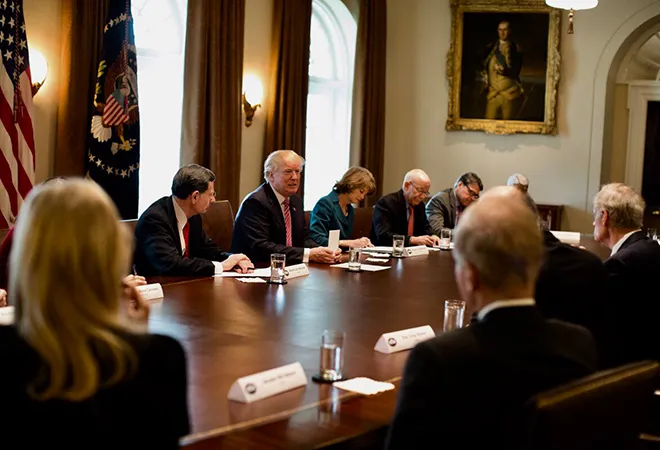
On January 26, The Washington Post reported that the Donald Trump administration is expected to seek a staggering $716 billion in defence spending in its 2019 budget. The proposed budget would be “a 13 per cent increase over 2017, when the United States spent about $634 billion on defence.” The planned increase in defence spending comes after President Donald Trump promised his maiden national security strategy to be a “major departure from the past” with respect to “once again investing in our defense – almost $700 billion, a record, this coming year.” In the Trump administration’s National Security Strategy, this call to “renew America’s competitive advantages” was summarised as the Trump administration’s will to ‘Preserve Peace Through Strength’. However, this emphasis on sustaining the United States’ military superiority “across a full spectrum” is not exclusively Trump’s.
Through the twentieth century, calls to hone military superiority have been a recurring tenant in US security policy –– from President Franklin Roosevelt’s call for amassing the “great arsenal of democracy” to defeat the forces of fascism, to successive administrations through the Cold War hunkering down to confront the “hostile design” of the Soviet Union. The Cold War saw US defence spending peak at 13.2 percent and 9.5 percent share of US GDP during the Korean and the Vietnam Wars, respectively. Further, even as the Cold War was sputtering to a close, under the Reagan administration’s assertion of securing “peace through our strength; (since) weakness only invites aggression”, US defence procurement budget soared “to $147.3 billion from $71.2 billion in 1980”.
In the post-Cold War world, the emphasis on maintaining American military superiority assumed greater relevance as the United States faced an impending economic decline in face of the rise of the rest. As the global economy’s axis shifted to the east, sustenance of US military superiority became the silver bullet – if you will, to preserve American primacy and the liberal world order at-large.
Hence, despite being bereft of the Cold War rationale, through the nineties, the United States and its allies continued to account for “a formidable 75 percent of global military spending” and US defence spending declined by a meagre 3 percentage share points to US GDP in the period of a decade (Data: World Bank). This post-Cold War “peace dividend” failed to be a substantive one as successive administrations continued to advocate for maintaining America’s military “edge” in newer contexts. Thus, as new threats were deemed to evolve in the post-Cold War world, the raison d’être for higher defence spending too differed through successive administrations.
Hence, in the aftermath of the dissolution of the Soviet Union, the George H. W. Bush administration sought to simply redefine and not limit the US military’s role. President Bush deemed the sustenance of America’s sprawling defence architecture as central to the “promise of a new world order, where brutality will go unrewarded and aggression will meet collective resistance”. Thus, the 1991 National Security Strategy underscored “a forceful reminder that there are still autonomous sources of turbulence in the world”, and called for investment strategies to “hedge against the unknown, giving future Presidents the flexibility” that comparatively advantageous capabilities provide. Similarly, the Clinton administrations advocated for maintaining “overarching capabilities" for future contingencies even as it embroiled itself in humanitarian interventions in Eastern Europe and Sub-Saharan Africa. For instance, the 1996 National Security Strategy underscored “near-simultaneous hostilities with North Korea and Iraq” to require capabilities that “deter and, if necessary, defeat aggression in concert with regional allies in two nearly simultaneous major regional conflicts”.
Subsequently, jolted by the attacks of 11 September, 2001, the George W. Bush administration emphasised the US military’s role as the ‘tip of the spear’ in meeting policy ends. The 2002 National Security Strategy underscored the need to “build and maintain our defenses beyond challenge”. Further, the 2006 National Security Strategy purported it to be aimed “to extend freedom across the globe by leading an international effort to end tyranny and to promote effective democracy.”
Defence spending under this expansive rationale amounted to the largest US defence build-up since the aforementioned Reagan build-up. In figures adjusted to the 2009 US dollar levels, defence spending in the Bush era rose by a staggering 47%, peaking at $661 billion in 2009 – including Overseas Contingency Operations (OCO) figures. Even under President Barack Obama, US defense spending continued to be high despite the congressionally imposed sequester and drawing down of the wars in Iraq and Afghanistan. Although the winding down of the aforementioned wars drastically decreased the OCO figures, the base budget figures under the Obama administration increased “from $497.3 billion to $521.7 billion, an increase of 5 per cent” from 2015 to 2016 alone. Further, on comparing eight years of the Obama administration’s base budgets with the Bush administration’s, Obama’s “exceeds Bush’s by a sum total of $816.7 billion.” In the Obama administration’s national security literature, this increase in defence spending was often construed in the lexicon of ‘American Exceptionalism’. For instance, the 2010 Quadrennial Defense Review stated, “America’s interests and role in the world require armed forces with unmatched capabilities and a willingness on the part of the nation to employ them in defense of our interests and the common good.”
This emphasis on sustaining US primacy vis-à-vis its military capabilities continues to hold credence in the Trump era. Moreover, as in the case of previous post-Cold War administrations, merely the jargon adopted to justify higher defence budgets has changed. For instance, in his 18 December, 2017 speech, President Trump invoked the aforementioned Reagan administration principle of “peace through strength” in the context of emerging threats of the 21st century. Promising to “recognize that weakness is the surest path to conflict, and unrivaled power is the most certain means of defense,” President Trump spoke of “a new era of competition” requiring the United States to ace “vigorous military, economic, and political contests are now playing out all around the world.” In January, whilst unveiling the US National Defense Strategy, Secretary of Defense James Mattis similarly argued to “restore our comparative military advantage” to address “great power competition, not terrorism” as the “primary focus of US national security.”
Further, the National Security Strategy and the National Defense Strategy deemed a US military “overmatch” competitive advantage to be central to the “long-term strategic competitions” with China and Russia that “want to shape a world antithetical to US values and interests” – aimed to “weaken” America’s influence.
In summation, Trump’s National Security Strategy does appear to be a “major departure” from the George H. W. Bush years’ promise of the “New World Order”, the Bill Clinton years’ focus on preparedness for “multiple major” regional contingencies, the George W. Bush era’s crusade against “tyranny”, and the Barack Obama administrations’ bullishness over American stewardship on the world stage. It nevertheless preserves the enduring tenant of US security policy of persevering Washington’s primacy via sustaining America’s military superiority. The Trump administration’s focus on sustaining the US military’s superiority – although in its new context of “great power competition” – therefore reflects a classic primacist American world view than a disruptive, ‘drain-the-swamp’ Trump outlook.
The author is a Research Fellow at Observer Research Foundation, Mumbai.
The views expressed above belong to the author(s). ORF research and analyses now available on Telegram! Click here to access our curated content — blogs, longforms and interviews.




 PREV
PREV


